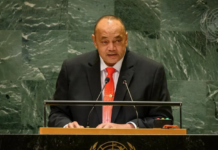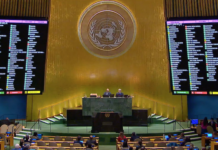
By Eloise Gibson, RNZ climate change correspondent
While attention is focused on economists finding a $500 million-a-year hole in National’s tax plans, a similar-sized hole in climate costings is hiding in plain sight — and it applies to Labour, too.
National appears to have the bigger gap, however.
The gulf was highlighted in the Pre-election Economic and Fiscal Update (PREFU) — Treasury’s official word on the state of the government’s books — which explicitly excluded the cost of meeting New Zealand’s international climate target under the Paris Agreement.
Asked how they would pay this week, politicians gave unclear answers. But the obligation was still very real.
Both Labour and National have said they are committed to meeting the country’s international climate target, known as an NDC (Nationally Determined Contributions).
Under the Paris Agreement, which covers almost every nation on the planet, New Zealand has promised to cut emissions by 41 percent off 2005 levels by 2030. Exporters and carbon market experts say failing to meet that pledge could jeopardise international trade — nevermind the fact that following the Paris Agreement is humanity’s best hope for avoiding more expensive and deadly heating.
New Zealand plans to meet its target in two ways. First, it will do as much as it can inside the country by meeting a set of “emissions budgets”.
No way to meet target
But when the Climate Change Commission ran the numbers, it concluded there was no way to meet the whole target with action at home. Because New Zealand started slow at tackling emissions, cutting transport, industry, farming and electricity emissions that quickly would cause too much economic pain, it concluded.

So there is also a second part to the target: buying carbon credits from overseas. Typically, economists assume this is cheaper than making cuts in emissions at home, though it depends on the project.
While no purchases will be made until after the election, the kinds of things that could qualify include retiring coal boilers in developing countries, or planting forests.
This is where the gap in the books comes in. Treasury had previously put the cost of buying these credits from overseas — and an estimated 100 million tonnes of them will be needed, at last count — at between $3.3 billion and more than $23 billion between now and 2030.
Even at the lower end of projections, it could work out at around $500 million a year.
Whichever way the government decides to do it, PREFU said the costs would be “significant” and will start biting “within the current fiscal forecast period”.
As things stand, according to Climate Change Minister James Shaw, one or possibly two rounds of purchases could be made in the next four years, with a third and final “washup” at the end of the decade.
Election may change timing
The election could change the timing, but whoever is in government will be expected to start showing progress towards meeting their Paris target well before the end of the decade, said carbon market expert Christina Hood from Compass Climate.

“There’s this common misconception that whoever the finance minister is in 2032 is going to have to get their chequebook out and square up by however much we missed by. It doesn’t work that way at all.
“Every emission (saving) we count has to actually occur during those years (before 2030), so we need to get on with funding that.”
Yet despite starting to fall due within the next four years, the costs did not appear as a liability on the government’s books. Nor do the major parties seem to be clear on how much to budget for them.
Bold claims, few details
This week, neither National nor Labour answered clearly how much they had planned to set aside for these costs nor how they intended to pay them. They instead focused their answers on wanting to cut planet-heating emissions more deeply inside New Zealand’s borders.
At times, politicians seemed to confuse domestic emissions budgets with the $3 billion-plus added cost of buying offsets to meet the Paris target, or they made heroic statements about how much they could do onshore, without supplying the figures behind them.
A quick reminder: the 100-odd million tonnes in overseas offsets that it was estimated we would need were on top of meeting New Zealand’s domestic emissions budgets, not instead of it. Only a truly incredible effort could meet the entire amount inside the country, requiring deep and fast climate action on a scale neither party has hinted at.
Currently, New Zealand is not even on track to meet its domestic emissions budgets, as Climate Change Commission chief executive Jo Hendy told a business and climate conference in Auckland this week.
“Latest projections show we are not on track in every single sector, so we are going to have to do more,” she said. “We are particularly reliant on pushing the dial in transport and in process heat.”
Yet when RNZ asked about the $3 billion-plus cost on the campaign trail, politicians appeared to be planning to overperform on those budgets, sometimes by impressive amounts. Their answers suggested they may not need to worry too much about that $3 billion-plus.
Here’s what Labour leader Chris Hipkins said, when asked if he had costed for meeting Paris: “We still have a way to go before we have to make a final decision on how best to meet our commitments there. We’re on track to meet our first emissions budget.
Working harder
“We’ve still got the second and third emissions reduction budgets to go. If we don’t meet our targets there is a period of time when we can figure out how best to remedy that, and that includes working harder in the second period to compensate for that.
“But we’re confident that with the stuff we’ve got in place at the moment, we’re on track to meet our first target.”
Hipkins did not address paying for offshore credits, which were required even if the country met all three domestic budgets. As prime minister, he rolled back a biofuel policy and, like National, has focused his transport promises mainly on building new roads rather than a strong shift to lower-emissions modes.
He has also promised help for home insulation and solar, but it was not clear if his new promises compensated for the cuts.

Asked the same question, National leader Christopher Luxon took aim at the government for undermining the Emission Trading Scheme (ETS), saying the scheme should do more of the “heavy lifting”.
He, too, skirted the question of paying for offsets.
For context, the ETS made polluters pay for around half the country’s domestic climate pollution (the other half was from agriculture) and was already factored into projections of needing 100 million-odd tonnes of extra ‘top up’ help from overseas.
The scheme could do more, particularly if carbon prices went higher (taking petrol prices with them), or if farming was included, or if there were no limits on planting land in cheap pine trees, but Luxon did not detail how National would navigate these kinds of changes.
Cutting domestic emissions
Meanwhile, other party spokespeople talked-up cutting domestic emissions.
Labour environment spokesperson David Parker told the conference in Auckland he wanted to look at claims that native afforestation could meet the entire Paris target (without overseas help).

National’s climate spokesperson Simon Watts told the same gathering — the annual Climate Change and Business Conference — that National believed it could meet 70-75 percent of the 2030 target inside these shores, a figure considerably higher than previous estimates by the Climate Change Commission.
Watts did not supply details on how that would be achieved, though he discussed lightening regulation on wind and solar energy.
His party has said it would scrap Labour’s Clean Car Discount and major grants to companies to switch off coal boilers, and it would also delay pricing farming emissions a further five years, until 2030. There were questions about how it would meet even the current domestic emissions budgets.
The cost of waiting
Hood had a spot of good news on the cost front. She told RNZ that based on recent purchases by Switzerland, the cost of overseas carbon offsets was likely to be towards the lower end of Treasury’s range.
Even if the government winded up buying 100 million tonnes of savings offshore, that was still only around half the quantity the John Key-led government expected it might have to stump up for when it made its first Paris Agreement pledge, despite the first pledge being weaker on climate than the current one, she noted.
But getting offsets at the lower end of the cost range relies on the government getting moving on lining them up and buying them, she says.
Shaw told RNZ that environmental integrity would be a bottom line after New Zealand was burned for buying valueless “hot air” credits from Russia and Ukraine in the early years of carbon trading.
As well as Switzerland, Singapore and others had already started striking deals to buy the offsets they needed.
While the New Zealand Government has been scoping out prospective sellers overseas, it has refused to reveal who it is talking to, citing commercial sensitivity.
The ministries for Foreign Affairs and the Environment were working on advice to Cabinet on how to make these purchases and ensure the carbon saved was real. But that advice will not land until after the election.
Most expensive time to buy
One thing is clear. 2030 will be the most expensive time to buy, Hood said, because many countries will be panic-buying from overseas projects to meet their missed domestic commitments. Shaw agreed.
“A whole bunch of countries will be going, ‘Oh crap, I’ve missed my target,’ and scrambling around trying to find ways to fill the gap.”
Shaw wanted Paris costs to go into PREFU, making it clear to the government that any money spent on domestic action on climate change was also a cost saving in terms of buying fewer offshore credits.
“This is one of the things that worries me about what some of the other parties are saying, is that they aren’t really accounting for [Paris] in their fiscal plans.”
Shaw called the huge variance in Treasury ‘s $3 billion-23 billion estimate “unhelpful”.
“It’s such a wide variance it’s hard to trust it. At the moment… people are putting their fingers in their ears and saying ‘lalalala”.”
But asked how much the Green Party had costed for meeting New Zealand’s offshore climate commitments, Shaw would not be drawn on naming a more accurate number.
Treasury estimate best
“The best estimate I’ve got is the Treasury estimate. The Ministry for the Environment and MFAT (Ministry for Foreign Affairs and Trade) are doing a lot of work on this at the moment, but they’re not going to have a report back until just before Christmas. If I was to give you a number I would be pulling it out of thin air.”
As for how to pay for it, Shaw said ETS proceeds from polluters could do a lot of it.
“In a good year that’s a billion dollars, so if there’s seven years for us to do that it’s $7 billion.”
But Shaw also acknowledged there were a lot of other calls on that money — including for adapting to climate change, paying for domestic carbon savings, and helping low-income families weather the costs of higher emissions prices, which boost fuel and electricity costs.
National has said it would use ETS proceeds to help fund its tax cuts, meaning it will need to pay for the Paris target (both the offshore and onshore parts) some other way.
This article is republished under a community partnership agreement with RNZ.















































